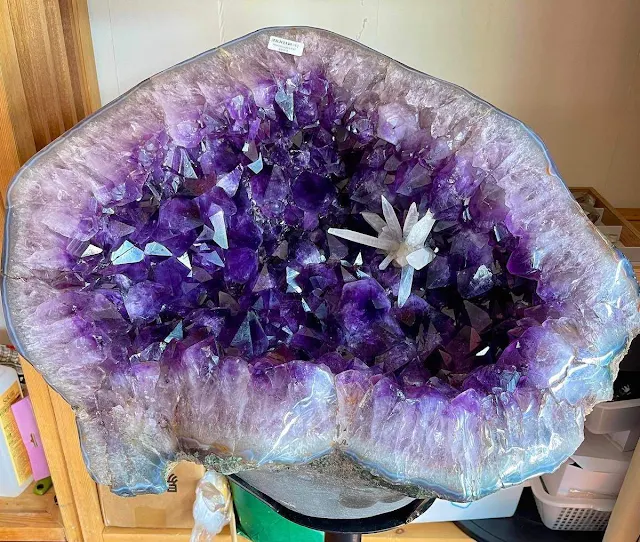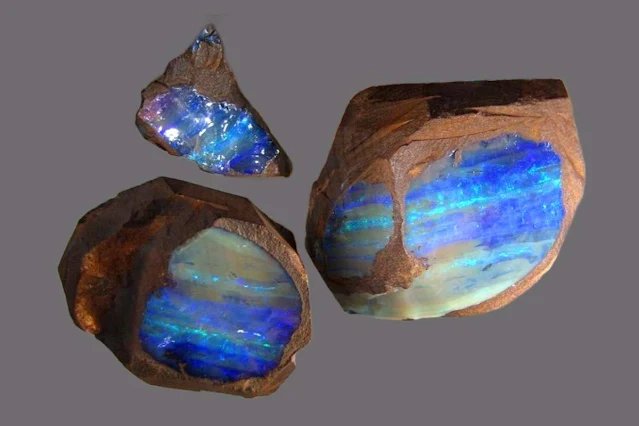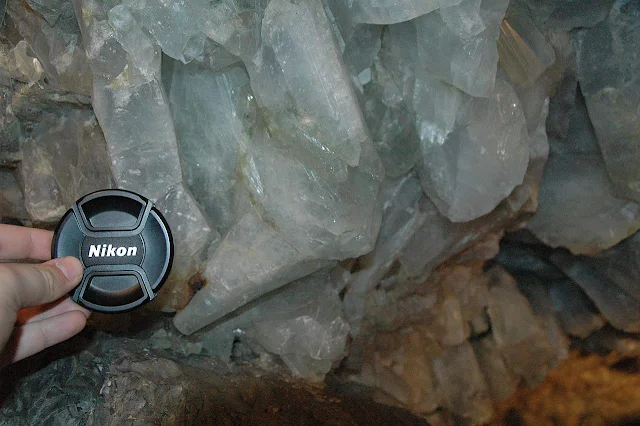What is a Geode, Types of Geodes
What is a Geode
A geode is a geological formation characterized by a hollow interior lined with mineral crystals. These formations typically exhibit a spherical or subspherical shape, although some can be oblong, and they vary greatly in size, from small, pea-sized cavities to large, cave-like structures. The exterior is usually composed of a dense, hard rock, such as basalt or limestone, enclosing the hollow interior. Inside, the cavity is lined with crystals that can differ widely in size, color, and type, depending on the minerals present during the geode's formation. Geodes are formed through geological processes that occur over thousands to millions of years, making them a fascinating example of nature's slow but profound transformations.
Geodes are not just rocks; they are snapshots of ancient environments. Their formation, spanning millions of years, captures mineral-rich fluids that infiltrated and crystallized within their hollow cavities, preserving a record of past geological events.
How Are Geodes Formed
Geodes form in two main ways, both involving the creation of hollow spaces within rocks and the subsequent filling of those spaces with mineral crystals. Here's a breakdown of each process:
Volcanic Geodes
Gas Bubbles: As lava flows cool and harden, gas bubbles trapped within can leave behind empty cavities. These bubbles can form due to various factors like the release of gases during volcanic eruptions or the expansion of water vapor trapped within the molten rock.
Hydrothermal Fluids: Over time, mineral-rich hydrothermal fluids – hot water solutions carrying dissolved minerals – seep through the surrounding rock and into these cavities.
Crystallization: As the hot fluids cool and interact with the cavity walls, the dissolved minerals start to precipitate out of solution, forming crystals that gradually grow and line the interior. The specific types of crystals that form depend on the composition of the fluids and the surrounding rock.
Sedimentary Geodes
Dissolution and Replacement: Within sedimentary rocks, certain materials like shells, tree roots, or concretions (mineralized lumps) can dissolve or decay over time, leaving behind hollow spaces.
Fluid Infiltration: Similar to volcanic geodes, mineral-rich fluids from groundwater or other sources seep into these cavities.
Crystallization: As the fluids interact with the cavity walls, the dissolved minerals precipitate and form crystals, gradually filling the space. The specific types of crystals that form depend on the composition of the fluids and the surrounding rock.
 |
| Chalcedony on Chrysocolla Stalactites Inspiration Mine, Inspiration, Globe-Miami District, Gila Co., Arizona, USA Photo: The Arkenstone, iRocks.com |
Factors Influencing Crystal Formation
Fluid Composition: The types of minerals dissolved in the fluids will determine the types of crystals that form.
Temperature and Pressure: These factors can influence the rate and type of crystal growth.
pH and Ionic Strength: The acidity or alkalinity and the concentration of dissolved ions in the fluids can affect crystal formation.
Diffusion Rates: The rate at which mineral ions move within the cavity and interact with existing crystals can influence their final form and arrangement.
Geodes Properties
Morphology: Typically spherical or subspherical, though shapes can vary from flattened discs to irregular nodules. Size also spans the spectrum, ranging from tiny pebbles to boulders exceeding a meter in diameter.
Interior Cavity: Can be completely hollow or partially filled with mineral deposits or remnants of the original cavity-forming material.
Mineral Composition: The inner crystals can comprise diverse minerals, with quartz, agate, amethyst, calcite, and celestine being particularly common. Other, less frequent minerals include pyrite, marcasite, and even opal.
Hardness: Varies depending on the mineral compositions of both the shell and the crystals but generally ranges from moderate to hard on the Mohs scale (3-7).
Crystal Habit: The crystals exhibit various forms and textures, such as drusy (densely packed individual crystals), botryoidal (grape-like clusters), or well-developed individual crystals.
Geodes Types and Varieties
1. Volcanic Geodes:
These originate from gas bubbles trapped within solidifying lava flows.
Agate Geodes: Characterized by concentric bands of chalcedony, agate, and other silica minerals, often displaying intricate patterns and vibrant colors. These bands reflect variations in the composition and physicochemical conditions of the infilling fluids.
Amethyst Geodes: Distinguished by the presence of amethyst, a purple variety of quartz. The amethyst coloration arises due to trace amounts of iron and irradiation.
 |
| Amethyst Geode |
Quartz Geodes: The most common type, containing various forms of quartz crystals, including druzy clusters, well-developed individual crystals, and geometric formations. The specific crystal morphology depends on factors like temperature, pressure, and growth rate.
2. Sedimentary Geodes:
These form through the dissolution and replacement of organic matter (e.g., shells, tree roots) or concretions within sedimentary rocks.
 |
| Calcite - amethyst geode - Uruguay |
Calcite Geodes: Composed primarily of calcite, a calcium carbonate mineral, often forming delicate clusters, stalactites, and translucent geodes resembling ice crystals. Calcite's diverse crystal habits and color variations contribute to their visual appeal.
Celestine Geodes: Characterized by the presence of celestine, a blue or colorless sulfate mineral, often forming delicate clusters or radiating formations.
Pyrite Geodes: Featuring pyrite, a brassy-yellow iron sulfide mineral, often occurring as individual crystals, clusters, or radiating rosettes.
 |
| Celestine geode |
Additional Varieties:
Botryoidal Geodes: Characterized by the presence of grape-like clusters of spheroidal or hemispherical crystals, primarily composed of quartz or calcite.
 |
| Botryoidal chalcedony Geodes |
Pseudomorphs: Occasionally, the original material filling the cavity (e.g., fossils, concretions) undergoes replacement by mineralizing fluids, leaving behind intricate textures and shapes preserved within the geode.
Drusy Geodes: Their inner surfaces are completely covered in a dense carpet of tiny crystals, creating a dazzling sparkle effect. It's like peering into a miniature gem-encrusted cave.
Enhydro Geodes: Rare geodes containing liquid water (frequently accompanied by a gas bubble) trapped within the cavity.
 |
| Enhydro Geodes |
Where to Find Geodes
Geodes are found in diverse geological settings, but some areas are more prone to their occurrence:
Volcanic Regions: Regions with past volcanic activity, such as solidified lava flows, volcanic ash beds, and desert environments, offer a higher probability of encountering volcanic geodes.
Sedimentary Formations: Limestone and other sedimentary rocks formed from ancient marine environments can harbor sedimentary geodes, particularly in exposed rock faces, riverbeds, and quarries.
 |
| Unbroken geodes |
Known Geode Localities
California:
Oat Mountain Mine, Kern County: Boasts a variety of geode types, including volcanic geodes with agate, amethyst, and quartz crystals.
Calico Ghost Town, San Bernardino County: Offers opportunities to find volcanic geodes with quartz and agate crystals, sometimes showcasing botryoidal formations.
Hollister Hills State Park, San Benito County: A hotspot for sedimentary geodes, particularly calcite geodes with beautiful druzy clusters and stalactites.
Death Valley National Park: Features volcanic and sedimentary geodes with diverse mineral compositions, including agate, amethyst, and even jasper.
Owens Valley, Inyo County: Offers opportunities to unearth volcanic geodes, primarily containing quartz crystals with various textures and formations.
Arizona:
Cave Creek, Maricopa County: Renowned for its abundance of volcanic geodes filled with agate, chalcedony, and quartz crystals, often exhibiting intricate banding patterns.
Superior, Pinal County: A historic mining district known for its sedimentary geodes, particularly calcite and celestine geodes with delicate crystal clusters and formations.
Petrified Forest National Park: Offers potential for finding agate and quartz geodes within petrified wood, presenting a unique combination of geological treasures.
Globe Miami Area, Gila County: A region with diverse geode types, including volcanic geodes with agate and quartz crystals and sedimentary geodes with calcite and celestine.
Bisbee, Cochise County: A historic mining district with potential for finding geodes containing various minerals, including quartz, amethyst, and even pyrite.
 |
| Opal Geodes from Australia |
Texas:
Marfa, Presidio County: Known for its sedimentary geodes, particularly calcite geodes with translucent "iceberg" formations and druzy clusters.
Balmorhea State Park, Reeves County: Offers opportunities to find sedimentary geodes, including calcite and celestine geodes, within the limestone cliffs surrounding the park.
Terlingua Creek, Brewster County: A potential location for encountering volcanic geodes, particularly those containing agate and quartz crystals, along the creek bed.
Eagle Ford Formation, South Texas: A geological formation known for its sedimentary geodes, primarily calcite geodes with diverse crystal textures and formations.
Big Bend National Park: A vast region with potential for finding both volcanic and sedimentary geodes, depending on the specific location within the park.
 |
| Thunderegg agate, Oregon |
Geodes Uses
Decoration:
Interior design: Geodes, with their unique and often colorful crystal formations, are widely used as decorative elements in homes and businesses. They can be displayed on shelves, coffee tables, bookcases, or used as centerpieces.
Outdoor landscaping: Large geodes can serve as eye-catching accents in gardens, rockeries, or water features.
Jewelry: Geodes are incorporated into various jewelry pieces, including earrings, pendants, necklaces, and bracelets. The crystals are often sliced and polished to showcase their intricate patterns.
Practical Uses:
Paperweights: Geodes, due to their weight, can effectively hold down papers and documents.
Bookends: A pair of geodes can serve as attractive and functional bookends.
Educational tools: Geodes are valuable in teaching geology and earth science concepts, as they provide a visual representation of crystal formation and mineral composition.
The World’s Largest Geode
The Pulpi Geode in Spain
 |
| The Pulpi Geode in Spain. |
Pulpí Geode (Spain): Located in an abandoned silver mine near Pulpí, Spain, this massive geode measures a whopping 26 feet long, 6 feet wide, and 5.5 feet high. Its volume comes in at around 390 cubic feet (11 cubic meters). The stunning interior is lined with translucent selenite crystals, some reaching up to 6 feet long, making it a truly breathtaking sight.
It's officially recognized by the Guinness World Records as the largest documented geode in the world.
Crystal Cave in Put-in-Bay, Ohio
 |
| Crystal Cave in Put-in-Bay, Ohio |
Crystal Cave (Ohio): Nestled beneath Heineman's Winery in Put-in-Bay, Ohio, this geode boasts a length of 35 feet (11 meters). While slightly smaller in dimension than the Pulpí Geode, it features incredible celestite crystals, some up to 3 feet long. The cave itself was discovered in 1897 and is now a popular tourist destination, offering visitors a glimpse into this captivating geode world.
So, who wins? It depends on what you consider "largest." Based on volume, the Pulpí Geode takes the cake. But for sheer length, the Crystal Cave in Ohio holds the record.
Thunderegg Vs Geode
A geode is a type of rock formation with a hollow interior lined with crystals. These beautiful creations can be found in various locations, from deserts and volcanic regions to riverbeds and limestone quarries.
A thunderegg is a type of volcanic rock with a concentrically layered interior, often containing chalcedony or agate. These fascinating formations are typically found in areas with past volcanic activity, like deserts and volcanic plains. Their smooth, often banded exteriors hint at the hidden treasures within, waiting to be revealed. Unlike geodes, thundereggs don't have hollow interiors. They form when molten lava cools rapidly, creating concentric layers of minerals around a gas bubble
In conclusion, geodes are not merely captivating geological curiosities but valuable scientific specimens offering insights into Earth's history and processes. Their diverse mineral composition, formation mechanisms, and multifaceted significance solidify their place as fascinating objects worthy of scientific exploration and aesthetic appreciation.
Read also:
The Giant Amethyst Geodes in Uruguay
10 Interesting Facts About Geodes
Thunder egg: Ordinary Rocks With Crystal Surprise Inside!








